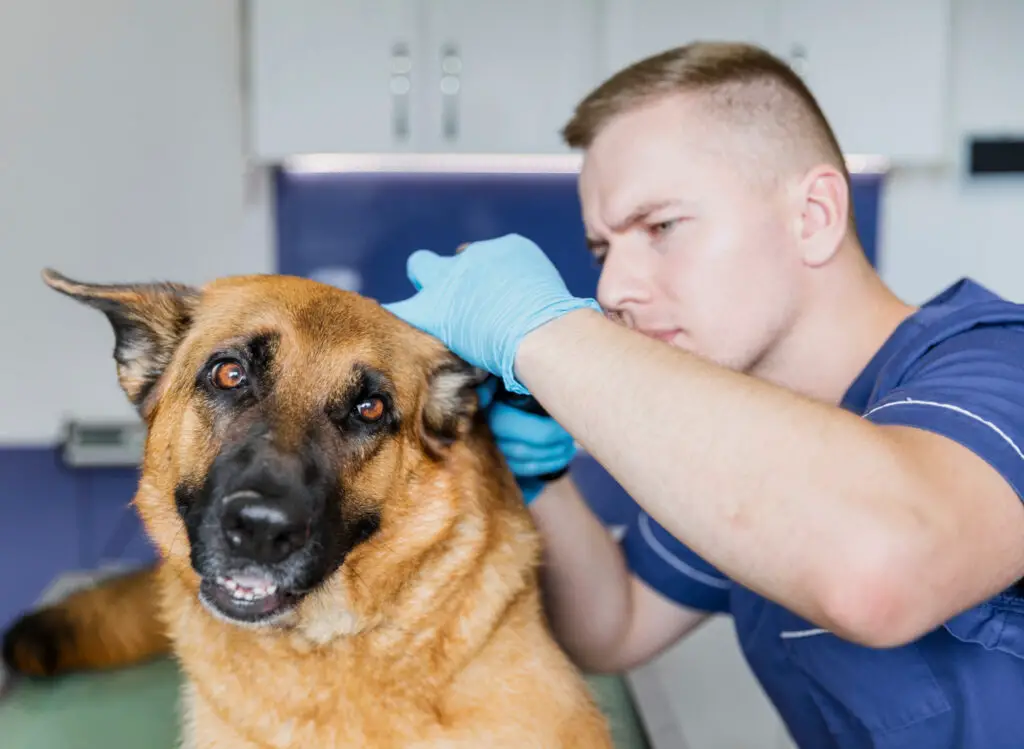Ringworm is a common fungal infection that can affect dogs, and it’s crucial for pet owners to be able to identify its appearance. As a responsible dog owner, knowing what ringworm looks like on a dog can help you provide timely care and prevent the spread of the infection to other pets and even humans. In this guide, we’ll define what does ringworm look like on a dog, including its appearance, symptoms, treatment, and frequently asked questions.
What Does Ringworm Look Like on a Dog?
Ringworm display as circular patches on a dog’s skin that often resemble a red ring or injury. Contrary to its name, ringworm is not caused by worms but by various fungal species, with the most common culprit being the Microsporum canis fungus. The affected area typically has a defined border, with a slightly raised and scaly or crusty edge. The center of the lesion may appear clearer and more healed.
Identifying Ringworm: Where to Look
Ringworm can appear on different parts of a dog’s body. Common areas where ringworm may develop include:
1. Face and Head:
Ringworm can affect a dog’s face and head, often around the eyes, ears, and muzzle. Look for circular patches with hair loss and redness.
2. Ears:
Check the ears for red, scaly, and crusty patches. Dogs with floppy ears may be more susceptible due to reduced air circulation.
3. Paws:
Ringworm can cause discomfort in a dog’s paws, leading to itching and redness. Pay attention to any circular lesions on the paw pads.
4. Body:
The body, including the back and sides, can develop ringworm patches. These lesions can vary in size and appearance.
5. Legs and Tail:
Inspect the legs and tail for circular areas of hair loss and inflammation.
What are Rigworms Symptoms in Dog
Aside from the characteristic appearance of circular injury, dogs with ringworm may exhibit the following symptoms:
- Itching: Affected dogs may scratch, lick, or bite at the infected areas due to discomfort.
- Hair Loss: Circular patches often result in hair loss, making them more noticeable.
- Redness and Inflammation: The outer edge of the lesion can be red, inflamed, and itchy.
- Scaling and Crusting: The border of the lesion may have a scaly or crusty texture.
- Secondary Infections: Scratching and open sores can lead to secondary bacterial infections.
Diagnose Ringworms And Prevention
Ringworm is highly transferable and can spread through direct contact with an infected animal, contaminated objects, or even from the environment. To prevent its spread:
- Isolation: Separate infected pets from healthy ones.
- Regular Cleaning: Disinfect grooming tools, bedding, and living areas.
- Hygiene: Wash your hands after handling an infected pet.
- Prompt Treatment: Consult a veterinarian for diagnosis and treatment.
What Are The Treatment Options for Dog Ringworm
Upon suspecting ringworm, consult a veterinarian for proper diagnosis and treatment. Treatment may include:
- Topical Medications: Anti fungal creams or ointments for localized infections.
- Oral Medications: Prescribed antifungal drugs for severe cases.
- Medicated Shampoo: Regular bathing with medicated shampoo to eliminate spores.
- Environmental Cleaning: Thoroughly clean and disinfect your home to prevent re-infection.
FAQs About what does ringworm look like on a dog
Q: Can I catch ringworm from my dog?
A: Yes, ringworm is zoonotic, meaning it can be transmitted between animals and humans.
Q: How long does it take for ringworm to clear up with treatment?
A: With proper treatment, mild cases can improve within a few weeks, while severe cases might take longer.
Q: Is ringworm more common in certain breeds?
A: While any dog can get ringworm, long-haired breeds may be more susceptible due to their fur’s density.
Q: Can I use over-the-counter antifungal creams?
A: It’s recommended to consult a vet before using any medication on your dog, as some creams may be unsafe.
Q: Will shaving my dog’s fur help with treatment?
A: Shaving can help expose the lesions, but it’s best to consult a vet before attempting this.
Conclusion
Being able to identify ringworm on your dog is essential for their well-being and the safety of your family. With its distinct circular patches, redness, scaling, and potential hair loss, ringworm is a treatable but contagious condition. By promptly seeking veterinary care and taking preventive measures, you can ensure a swift recovery for your pet dog. Remember, proper hygiene and cleanliness play a significant role in preventing and managing this fungal infection.


